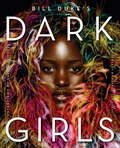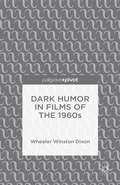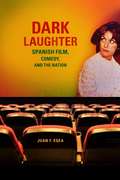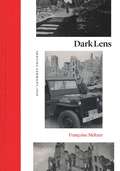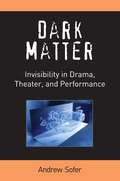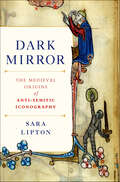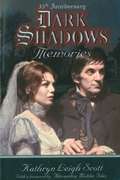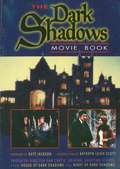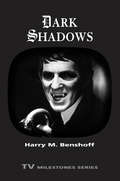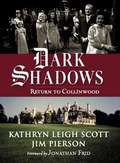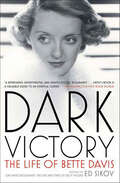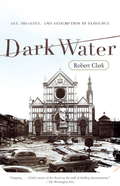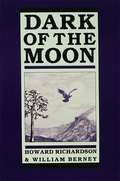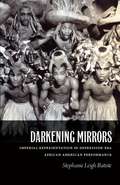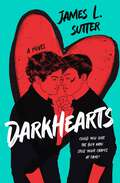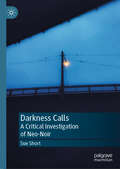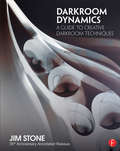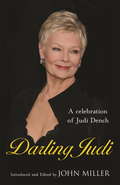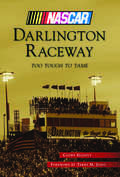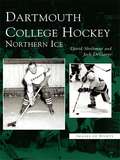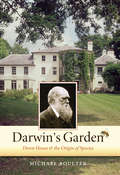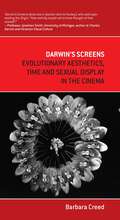- Table View
- List View
Dark Figures in the Desired Country: Blake's Illustrations to The Pilgrim's Progress
by Gerda S. NorvigThis title is part of UC Press's Voices Revived program, which commemorates University of California Press’s mission to seek out and cultivate the brightest minds and give them voice, reach, and impact. Drawing on a backlist dating to 1893, Voices Revived makes high-quality, peer-reviewed scholarship accessible once again using print-on-demand technology. This title was originally published in 1993.
Dark Girls
by Shelia P. Moses Bill DukeIn the tradition of the New York Times bestselling I Dream a World and Crowns comes this full-color companion volume to the acclaimed NAACP Award–nominated documentary Dark Girls—an inspiring and breathtaking photo book that celebrates dark-skinned women.Black has never been more beautiful, witnessed by this magnificent collection featuring accomplished dark skinned-women from all walks of life. In Dark Girls, celebrities such as Lupita Nyong'o, Vanessa Williams, Sheryl Lee Ralph, Judge Mablean Ephriam, Brandi and Karli Harvey, and over seventy-five other outstanding women share intimate insights into what their dark skin means to them.Filled with gorgeous photographs, this thoughtful, sophisticated, alluring, and uplifting collection captures the elegance of dark skin—joyfully showcasing that we truly are beautiful for who we are.
Dark Humor in Films of the 1960s
by Wheeler Winston DixonFocusing on "dark" or black comedy films in the US and the UK, Wheeler Winston Dixon provides a comprehensive overview of a variety of films and filmmakers (Vanishing Point, Marcel Hanoun), whose work has largely been ignored, but whose influence and importance is clearly present.
Dark Laughter
by Juan F. EgeaIn "Dark Laughter," Juan F. Egea provides a remarkable in-depth analysis of the dark comedy film genre in Spain, as well as a provocative critical engagement with the idea of national cinema, the visual dimension of cultural specificity, and the ethics of dark humor. Egea begins his analysis with General Franco's dictatorship in the 1960s--a regime that opened the country to new economic forces while maintaining its repressive nature--exploring key works by Luis Garcia Berlanga, Marco Ferreri, Fernando Fernan-Gomez, and Luis Bunuel. "Dark Laughter" then moves to the first films of Pedro Almodovar in the early 1980s during the Spanish political transition to democracy before examining Alex de la Iglesia and the new dark comedies of the 1990s. Analyzing this younger generation of filmmakers, Egea traces dark comedy to Spain's displays of ultramodernity such as the Universal Exposition in Seville and the Barcelona Olympic Games. At its core, " Dark Laughter" is a substantial inquiry into the epistemology of comedy, the intricacies of visual modernity, and the relationship between cinema and a wider framework of representational practices.
Dark Lens: Imaging Germany, 1945
by Françoise MeltzerThe ruins of war have long held the power to stupefy and appall. Can such ruins ever be persuasively depicted and comprehended? Can images of them force us to identify with the suffering of the enemy and raise uncomfortable questions about forgiveness and revenge? Françoise Meltzer explores those questions in Dark Lens, which uses the images of war ruins in Nazi Germany to investigate problems of aestheticization, the representation of catastrophe, and the targeting of civilians in war. Through texts that give accounts of bombed-out towns in Germany in the last years of the war, painters’ attempts to depict the destruction, and her own mother’s photographs taken in Berlin and other cities in 1945, Meltzer asks if any medium offers a direct experience of war ruins for the viewer. Ultimately, she concludes that while the viewer cannot help reimaging the devastation through the lenses of history, aestheticization, or voyeurism, these images at least allow us to approach the reality of ruins and grasp the larger issue of targeting civilians in modern warfare for what it is. Refreshingly accessible and deeply personal, Dark Lens is a compelling look at the role images play in constructing memories of war.
Dark Matter: Invisibility In Drama, Theater, And Performance
by Andrew SoferDark Matter maps the invisible dimension of theater whose effects are felt everywhere in performance. Examining phenomena such as hallucination, offstage character, offstage action, sexuality, masking, technology, and trauma, Andrew Sofer engagingly illuminates the invisible in different periods of postclassical western theater and drama. He reveals how the invisible continually structures and focuses an audience’s theatrical experience, whether it’s black magic in Doctor Faustus, offstage sex in A Midsummer Night’s Dream, masked women in The Rover, self-consuming bodies in Suddenly Last Summer, or surveillance technology in The Archbishop’s Ceiling. Each discussion pinpoints new and striking facets of drama and performance that escape sight. Taken together, Sofer’s lively case studies illuminate how dark matter is woven into the very fabric of theatrical representation. Written in an accessible style and grounded in theater studies but interdisciplinary by design, Dark Matter will appeal to theater and performance scholars, literary critics, students, and theater practitioners, particularly playwrights and directors.
Dark Mirror: The Medieval Origins of Anti-Semitic Iconography
by Sara LiptonIn Dark Mirror, Sara Lipton offers a fascinating examination of the emergence of anti-Semitic iconography in the Middle AgesThe straggly beard, the hooked nose, the bag of coins, and gaudy apparel—the religious artists of medieval Christendom had no shortage of virulent symbols for identifying Jews. Yet, hateful as these depictions were, the story they tell is not as simple as it first appears.Drawing on a wide range of primary sources, Lipton argues that these visual stereotypes were neither an inevitable outgrowth of Christian theology nor a simple reflection of medieval prejudices. Instead, she maps out the complex relationship between medieval Christians' religious ideas, social experience, and developing artistic practices that drove their depiction of Jews from benign, if exoticized, figures connoting ancient wisdom to increasingly vicious portrayals inspired by (and designed to provoke) fear and hostility.At the heart of this lushly illustrated and meticulously researched work are questions that have occupied scholars for ages—why did Jews becomes such powerful and poisonous symbols in medieval art? Why were Jews associated with certain objects, symbols, actions, and deficiencies? And what were the effects of such portrayals—not only in medieval society, but throughout Western history? What we find is that the image of the Jew in medieval art was not a portrait of actual neighbors or even imagined others, but a cloudy glass into which Christendom gazed to find a distorted, phantasmagoric rendering of itself.
Dark Scenes from Damaged Earth: The Gothic Anthropocene
by Justin D. Edwards Rune Graulund Johan HöglundAn urgent volume of essays engages the Gothic to advance important perspectives on our geological era What can the Gothic teach us about our current geological era? More than just spooky, moonlit castles and morbid graveyards, the Gothic represents a vibrant, emergent perspective on the Anthropocene. In this volume, more than a dozen scholars move beyond longstanding perspectives on the Anthropocene—such as science fiction and apocalyptic narratives—to show that the Gothic offers a unique (and dark) interpretation of events like climate change, diminished ecosystems, and mass extinction.Embracing pop cultural phenomena like True Detective, Jaws, and Twin Peaks, as well as topics from the New Weird and prehistoric shark fiction to ruin porn and the &“monstroscene,&” Dark Scenes from Damaged Earth demonstrates the continuing vitality of the Gothic while opening important new paths of inquiry. These essays map a genealogy of the Gothic while providing fresh perspectives on the ongoing climate chaos, the North/South divide, issues of racialization, dark ecology, questions surrounding environmental justice, and much more.Contributors: Fred Botting, Kingston U; Timothy Clark, U of Durham; Rebecca Duncan, Linnaeus U; Michael Fuchs, U of Oldenburg, Germany; Esthie Hugo, U of Warwick; Dawn Keetley, Lehigh U; Laura R. Kremmel, South Dakota School of Mines and Technology; Timothy Morton, Rice U; Barry Murnane, U of Oxford; Jennifer Schell, U of Alaska Fairbanks; Lisa M. Vetere, Monmouth U; Sara Wasson, Lancaster U; Jeffrey Andrew Weinstock, Central Michigan U.
Dark Shadows Memories
by Kathryn Leigh Scott Alexandra Moltke IslesDARK SHADOWS MEMORIES is a colorful, picture-packed tribute to the legendary 1966 - 1971 Gothic ABC-TV daytime series Dark Shadows, that starred Jonathan Frid as tormented vampire Barnabas Collins. Launched June 27, 1966 by series creator Dan Curtis as a Gothic romance evoking the gloomy, storm-tossed milieu of the Brontë sisters, and later evolving into a supernatural blend of vampires, witches, leviathans, time travel and parallel universes, Dark Shadows was radically unlike any daytime soap.
Dark Shadows Movie Book
by Kathryn Leigh Scott Kate JacksonThe Dark Shadows Movie Book is the first publication to examine and commemorate the two M-G-M theatrical motion pictures ("House of Dark Shadows" and "Night of Dark Shadows") based on the successful '60s Gothic television series "Dark Shadows."The Dark Shadows Movie Book features reproductions of the uncut original scripts to both films (which offer numerous rare scenes deleted from the film's release prints), complete with producer-director Dan Curtis' extensive script notes--offering unique insights to the filming process. The four female stars of the films--Kate Jackson, Lara Parker, Nancy Barrett and Kathryn Leigh Scott--contribute their recollections of the productions. The book also contains dozens of previously unpublished publicity photographs and behind-the-scenes shots, including many in full color."House of Dark Shadows," released in 1970, involves the story of reluctant vampire Barnabas Collins (Jonathan Frid) and his attempt to make Collinwood governess Maggie Evans (Kathryn Leigh Scott) his eternal bride. The film also starred veteran Hollywood screen actress Joan Bennett.
Dark Shadows: Dark Shadows (Tv Milestones Ser.)
by Harry M. BenshoffExplores the cultural, industrial, formal, and generic contexts of the television soap opera Dark Shadows as a precursor to today's popular gothic media franchises.
Dark Shadows: Return to Collinwood
by Kathryn Leigh Scott Jim Pierson Jonathan FridDark Shadows: Return to Collinwood presents a look back at four decadesof the successful spooky soap opera that made sympathetic vampire Barnabas Collins a pop culture phenomenon and prompted the big-budget, big-screen Warner Bros. revival starring longtime fan Johnny Depp, directed by Tim Burton, that premieres May 11, 2012. The large format book includes color photographs and behind-the-scenes anecdotes from Kathryn Leigh Scott and three other original cast members who filmed cameo roles with Johnny Depp, Helene Bonham-Carter and Michelle Pfeiffer in the new Gothic epic. With the ongoing fascination for all things vampiric, this book about the making of the new film and the history of the original series will be an enticing volume for new and old fans alike.This book also features hundreds of exclusive photographs of Dark Shadows then and now, along with behind-the-scenes information, production materials and unique archival elements that provide context for the Depp/Burton Warner Bros. film.The suspenseful Gothic tales of Dark Shadows center on the wealthy but tormented inhabitants of the mysterious Collinwood estate in the small fishing village of Collinsport, Maine, where the powerful Collins family has been haunted for generations by vengeful curses and other supernatural secrets that span the centuries.
Dark Victory: The Life of Bette Davis
by Ed SikovThe legendary Hollywood star blazes a fiery trail in this enthralling portrait of a brilliant actress and the movies her talent elevated to greatnessShe was magnificent and exasperating in equal measure. Jack Warner called her "an explosive little broad with a sharp left." Humphrey Bogart once remarked, "Unless you're very big she can knock you down." Bette Davis was a force of nature—an idiosyncratic talent who nevertheless defined the words "movie star" for more than half a century and who created an extraordinary body of work filled with unforgettable performances. In Dark Victory, the noted film critic and biographer Ed Sikov paints the most detailed picture ever delivered of this intelligent, opinionated, and unusual woman who was—in the words of a close friend—"one of the major events of the twentieth century." Drawing on new interviews with friends, directors, and admirers, as well as archival research and a fresh look at the films, this stylish, intimate biography reveals Davis's personal as well as professional life in a way that is both revealing and sympathetic. With his wise and well-informed take on the production and accomplishments of such movie milestones as Jezebel, All About Eve, and Now, Voyager, as well as the turbulent life and complicated personality of the actress who made them, Sikov's Dark Victory brings to life the two-time Academy Award–winning actress's unmistakable screen style, and shows the reader how Davis's art was her own dark victory.
Dark Water: Flood and Redemption in the City of Masterpieces
by Robert ClarkThis dramatic, beautifully written account of the flood that ravaged Florence, Italy, in 1966 weaves heartbreaking tales of the disaster and stories of the heroic global efforts to save the city's treasures against the historic background of Florence's glorious art. On November 4, 1966, Florence, one of the world's most historic cities and the repository of perhaps its greatest art, was struck by a monumental calamity. A low-pressure system had been stalled over Italy for six weeks and on the previous day it had begun to rain again. Nineteen inches fell in twenty-four hours, more than half of the annual total. By two o'clock in the morning twenty-thousand cubic feet of water per second was moving towards Florence. Soon manhole covers in Santa Croce were exploding into the air as jets of water began shooting out of the now overwhelmed sewer system. Cellars, vaults, and strong-rooms were filling with water. Night watchmen on the Ponte Vecchio alerted the bridge's jewelers and goldsmiths to come quickly to rescue their wares. By then the water was moving at forty miles per hour at a height of twenty-four feet. At 7:26 a. m. all of Florence's electric civic clocks came to a stop. The Piazza Santa Croce was under twenty-two feet of water. Beneath the surface, twelve feet of mud, sewage, debris, and oil sludge were starting to ooze and settle into the cellars and crypts and room after room above them. Six-hundred-thousand tons of it would smother, clot, and encrust the city. Dark Water brings the flood and its aftermath to life through the voices of witnesses past and present. Two young American artists wade heedlessly through the inundated city carrying their baby in order to witness its devastated beauty: the Ponte Vecchio buried in debris and Ghiberti's panels from the doors of the Florence Baptistery, lying heaped in yard-deep mud; the swamped Uffizi Gallery; and, in the city libraries, one billion pages of Renaissance and antique books, soaked in mire. A Life magazine photographer, stowing away on an army helicopter, arrives to capture a drama that, he felt, "could only be told by Dante" amid the flooded tombs of Machiavelli and Michelangelo in Giotto and Vasari's Santa Croce. A British student, one of thousands of "mud angels" who rushed to Florence to save its art, spends a month scraping mud and mold from Cimabue's magnificent and neglected Crocifisso as intrigues and infighting among international art experts and connoisseurs swirl around him. And during the fortieth anniversary commemorations of 2006 the author asks himself why art matters so very much to us, and how beauty seems to somehow save the world even in the face of overwhelming disaster.
Dark of the Moon
by Howard Richardson William BerneyAs the tale unfolds, a witch boy tarries in a mountain community in love with a beautiful girl named Barbara Allen. The superstitious townspeople resent their happiness and their subsequent meddling ends in violence and tragedy. This play was proclaimed a Broadway hit.
Darkening Mirrors: Imperial Representation in Depression-Era African American Performance
by Stephanie Leigh BatisteIn Darkening Mirrors, Stephanie Leigh Batiste examines how African Americans participated in U.S. cultural imperialism in Depression-era stage and screen performances. A population treated as second-class citizens at home imagined themselves as empowered, modern U.S. citizens and transnational actors in plays, operas, ballets, and films. Many of these productions, such as the 1938 hits Haiti and The "Swing" Mikado recruited large casts of unknown performers, involving the black community not only as spectators but also as participants. Performances of exoticism, orientalism, and primitivism are inevitably linked to issues of embodiment, including how bodies signify blackness as a cultural, racial, and global category. Whether enacting U.S. imperialism in westerns, dramas, dances, songs, jokes, or comedy sketches, African Americans maintained a national identity that registered a diasporic empowerment and resistance on the global stage. Boldly addressing the contradictions in these performances, Batiste challenges the simplistic notion that the oppressed cannot identify with oppressive modes of power and enact themselves as empowered subjects. Darkening Mirrors adds nuance and depth to the history of African American subject formation and stage and screen performance.
Darkhearts: A Novel
by James L. SutterPerfect for fans of Alice Oseman and Red, White, & Royal Blue, Darkhearts is a hilarious, heartfelt, enemies-to-lovers romance about love, celebrity, and what happens when the two collide.When David quit his band, he missed his shot at fame, trapped in an ordinary high school life while his ex–best friend, Chance, became the hottest teen pop star in America.Then tragedy throws David and Chance back into contact. As old wounds break open, the boys find themselves trading frenemy status for a confusing, secret romance—one that could be David’s ticket back into the band and the spotlight.As the mixture of business and pleasure becomes a powder keg, David will have to choose: Is this his second chance at glory? Or his second chance at Chance?
Darkness Calls: A Critical Investigation of Neo-Noir
by Sue ShortThis book examines the contrasting forms neo-noir has taken on screen, asking what prompts our continued interest in tales of criminality and moral uncertainty. Neo-noir plots are both familiar and diverse, found in a host of media formats today, and now span the globe. Yet despite its apparent prevalence—and increased academic attention—many core questions remain unanswered. What has propelled noir’s appeal, half a century on after its supposed decline? What has led film-makers and series-creators to rework given tropes? What debates continue to divide critics? And why are we, as viewers, so drawn to stories that often show us at our worst? Referencing a range of films and series, citing critical work in the field—while also challenging many of the assumptions made—this book sets out to advance our understanding of a subject that has fascinated audiences and academics alike. Theories relating to gender identity and neo-noir’s tricky generic status are discussed, together with an evaluation of differing comic inflections and socio-political concerns, concluding that, although neo-noir is capable of being both progressive and reactionary, it also mobilises potentially radical questions about who we are and what we might be capable of.
Darkroom Dynamics: A Guide to Creative Darkroom Techniques - 35th Anniversary Annotated Reissue
by Jim StoneBack in print 35 years after it was first published, Jim Stone’s classic darkroom manual provides step-by-step instructions for alternative creative darkroom techniques for experimental and manipulated photography. Each technique, presented by a photographer who is an expert in its application, includes how-to illustrations and reproductions of the photographer’s work. Perfect for students of darkroom photography, including those interested in experimental photography and alternative processing.
Darling Judi: A Celebration of Judi Dench
by VariousA celebration of Britain's favourite actress, Judi DenchThe very name Judi Dench encourages a warm and admiring response from the public and fellow actors alike. Her wide-ranging career includes numerous Shakespearean performances (most recently in ALL'S WELL THAT ENDS WELL at the RSC) and contemporary theatre (in plays by, among others, David Hare and Hugh Whitemore); on television (in the series A FINE ROMANCE and AS TIME GOES BY) and in the cinema (MRS BROWN, her Oscar-winning performance in SHAKESPEARE IN LOVE, THE SHIPPING NEWS, IRIS, and in four James Bond films as 'M').Judi Dench is as popular as she is talented - when she and Maggie Smith appeared together in a David Hare play last year all seats were sold for the entire run within 24 hours.John Miller, her biographer, invited fellow actors, writers, and people of the theatre, film and television, to illustrate her genius and her character from their own experience and perspective. With contributors ranging from Billy Connolly to Hugh Whitemore, Bob Larbey to Tim Pigott-Smith, this is a unique portrait of the legend that is Dame Judi Dench.
Darling Judi: A Celebration of Judi Dench
by VariousA celebration of Britain's favourite actress, Judi DenchThe very name Judi Dench encourages a warm and admiring response from the public and fellow actors alike. Her wide-ranging career includes numerous Shakespearean performances (most recently in ALL'S WELL THAT ENDS WELL at the RSC) and contemporary theatre (in plays by, among others, David Hare and Hugh Whitemore); on television (in the series A FINE ROMANCE and AS TIME GOES BY) and in the cinema (MRS BROWN, her Oscar-winning performance in SHAKESPEARE IN LOVE, THE SHIPPING NEWS, IRIS, and in four James Bond films as 'M').Judi Dench is as popular as she is talented - when she and Maggie Smith appeared together in a David Hare play last year all seats were sold for the entire run within 24 hours.John Miller, her biographer, invited fellow actors, writers, and people of the theatre, film and television, to illustrate her genius and her character from their own experience and perspective. With contributors ranging from Billy Connolly to Hugh Whitemore, Bob Larbey to Tim Pigott-Smith, this is a unique portrait of the legend that is Dame Judi Dench.
Darlington Raceway
by Cathy ElliottSome facilities are so special that they literally define their sport. Stock car racing as it is known today did not exist until one man, armed with a vision and a willingness to get his hands dirty, constructed a race track in the middle of a South Carolina peanut field. More than six decades later, Darlington Raceway is still considered one of the crown jewels of racing. "The Lady in Black" is home to the largest margin of victory in NASCAR® history and its closest-ever finish. The legendary track has been the proving ground for every superstar of the sport.
Dartmouth College Hockey: Northern Ice (Images of Sports)
by David Shribman Jack DegangeIn 1905, facing capricious weather on a primitive outdoor rink, Dartmouth's first hockey team took to the ice. In 1974, two years after coeducation came to the Hanover campus, Dartmouth women--fired with more competitive spirit than actual hockey experience commandeered the used equipment of their male counterparts and intramural skaters and became one of the college's most successful athletic teams. Dartmouth College Hockey: Northern Ice portrays two programs that have followed parallel paths to distinction in intercollegiate hockey. Rupert Thompson Arena, one of the nation's premier collegiate ice facilities, is home to the men and women of Dartmouth who have won numerous championships and earned All-American and Olympic acclaim, contributing to Dartmouth's rich tradition of athletic achievement.
Darwin's Garden: Down House and the Origin of Species
by Michael BoulterFive years after returning from his trip around the world, young Charles Darwin became the owner of Down House in Kent, England, where he moved his growing family, far away from the turmoil and distractions of London. He would live there for the rest of his life, and it would become the place where he began work on his masterpiece, On the Origin of Species.For almost twenty years, he used the garden around him as a laboratory. In the orchard, he conducted experiments on pollination. He built a dovecote where breeding new strains of pigeons helped him understand the intricacies of generation. On his daily walk along the sandbank, he observed how plants competed for survival. In solitude he struggled with the ideas of evolution that had haunted him since his voyage, which, in turn, gave him the courage to publish his revolutionary ideas.Bringing Darwin's garden to the present day, Boulter unfolds a shining portrait of the formation of one of England's greatest thinkers and his relationship with the place he loved, and shows how his experiments—conducted more than 150 years ago—are still revealing new proofs as we continue to search for the origins of life.
Darwin's Screens: Evolutionary Aesthetics, Time and Sexual Display in the Cinema
by Barbara CreedDarwin's Screens addresses a major gap in film scholarship—the key influence of Charles Darwin's theories on the history of the cinema. Much has been written on the effect of other great thinkers such as Freud and Marx but very little on the important role played by Darwinian ideas on the evolution of the newest art form of the twentieth century. Creed argues that Darwinian ideas influenced the evolution of early film genres such as horror, the detective film, science fiction, film noir and the musical. Her study draws on Darwin's theories of sexual selection, deep time and transformation, and on emotions, death, and the meaning of human and animal in order to rethink some of the canonical arguments of film and cinema studies.

